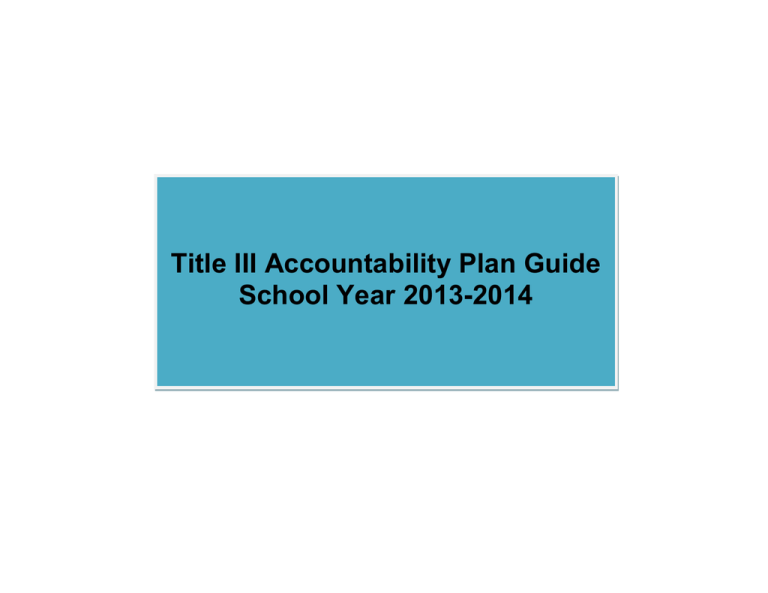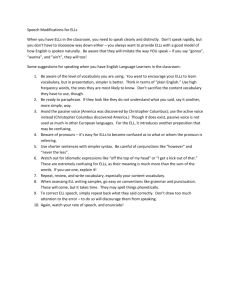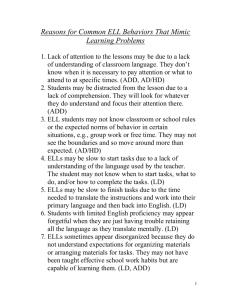TitleIII Guide
advertisement

Title III Accountability Plan Guide School Year 2013-2014 The goals of Title III English Language Acquisition are to ensure that all English language learners (ELLs) attain English proficiency and meet challenging state academic standards. To measure progress in meeting these goals, States receiving funds under Title III must develop annual measurable achievement objectives (AMAOs) which include three components: 1. Annual increases in the number or percentage of children making progress in learning English 2. Annual increases in the number or percentage of children attaining English proficiency and 3. Meeting performance goals as measured by the cumulative Progress and Performance Index (PPI) for the ELL subgroup as required in the (Massachusetts) ESEA Flexibility Waiver. The first two AMAOs are based on the English Language Proficiency Assessment results. In school year 2012-13, the ACCESS will be used to measure both progress in and attainment of English proficiency. A district must have at least 101 ELLs in order to be eligible to receive Title III funding and be held accountable for meeting AMAOs 1 and 2. The third AMAO is cumulative Progress and Performance Index (PPI) for the ELL and former ELL subgroup. The cumulative PPI incorporates MCAS scores in ELA, math, science and technology/engineering; growth in ELA and math; graduation rates and dropout rates. Cumulative PPI is calculated when there is an ELL subgroup of at least 30 in the tested grades in the district. Districts wishing to participate in Title III but not able to meet the minimum number of ELLs (more than 100) will join a consortium of other districts wishing to receive Title III funding. The consortium must select a lead agent to receive and manage the grant for the other participating districts. AMAOs 1 and 2 will be calculated for the consortium as a whole, whereas AMAO 3 will be calculated for individual districts in the consortium. The State annually determines the targets for each of the AMAOs. Targets for school year 2013-14 are set after the end of school year 2012-13. Districts must meet all three AMAOs each year in order to meet the Title III accountability requirements. If a Title III district does not meet all AMAOs for two consecutive years, it is required to develop an improvement plan that addresses the factors that prevented it from achieving all AMAOs. The plan will be in effect for two years. In an effort to ensure the district is meeting all AMAOs, and that ELLs have the best opportunities to learn, the district must address all of the items on the following pages in its improvement plan. 1) Establish a Team Title III requires districts missing any of the AMAOs for two consecutive years to write a Title III improvement plan to address the factors that prevented the district from meeting AMAOs. Additionally, missing any of the AMAOs for four consecutive years means that the State can require the district to modify its curriculum, program and method of instruction, or determine whether the district will continue to receive Title III funds related to the district’s failure to meet objectives and require the district to replace educational personnel responsible for the district’s failure to meet the objectives. Districts do not have to miss the same AMAO from year to year in order to be considered “missing AMAOs”. For this reason, focus should not be limited to a particular AMAO or challenge. It will take time, and a team of people with various areas of expertise to move the district toward ensuring ELLs have greater success in learning English and achieving academic standards. The Title III Improvement Team will develop the Title III Accountability Plan for the district. The responsibilities of the Title III Improvement Team are to gather and analyze qualitative and quantitative data, identify strengths and challenges in serving English language learners, set goals for improving AMAO status and success of ELLs, establish an action plan, and monitor the implementation and success of the action steps in the plan. Team members should include individuals who have expertise in Title III requirements, use of funds, achievement data, English language acquisition, and culture or cultural adjustment issues. Examples of possible team members include District Superintendent, Title III Director/Coordinator, teachers, testing coordinator, family or parent liaison, counselor, Special Education representative, and budget or fiscal personnel. Other team members may include a social worker or counselor if ELLs are struggling with adjusting to a new culture or way of life. For example, some ELLs coming from war-torn regions or who have experienced great personal turmoil or stress may be in need of counseling for issues beyond typical culture shock. There may be need for these roles on the team if the ELLs are from refugee or asylee families or have other special circumstances (international adoption, one parent out of the home, etc.) where the family may not be best able to interact with the district or communicate wants and needs as effectively as a member of their community, counselor or social worker could. In cases where there are a number of ELLs with special learning needs, a Special Education teacher or director should also be invited to participate in the improvement plan. Ideally, this person will be familiar with second language acquisition in students who also have Special Education needs. 2) Gather and Organize Data ACCESS □ Reading □ Writing □ Speaking □ Listening □ Entering level ELL performance □ Beginning level ELL performance □ Developing level ELL performance □ Expanding level ELL performance □ Bridging level ELL performance □ Language of Math □ Language of Language Arts □ Language of Social Studies □ Language of Science □ Staff Qualifications □ Other _______________________________ Gather data from the checkboxes above and describe what was gathered in the box provided in the Plan. The data gathered should be both qualitative and quantitative and can be in the form of surveys, assessment results, expense sheets, etc. Questions to consider for this part are provided below. Gather the ACCESS data and note how students are performing in schools with ELLs. Note, for example, whether a grade level, proficiency level or language domain is particularly outstanding. Note whether there is something very different about one school compared to another that may require change based on what these data reveal. Note students’ scores in the subtests – this can be used later to determine how close to the next level students are and whether particular students could benefit from some additional support to increase their scores more quickly. Identify individual students who show the least gain or the slowest growth. Gathering information about these students and their background or how they learn can be used to determine whether different, additional, or more intensive supports might be necessary. Also gather data on how well ELLs perform on the MCAS assessments. Document areas of particular difficulty for ELLs and determine whether content, language or academic language might need more focus. Note what ESOL program types are available to ELLs in the district. Some questions to consider: How long do students stay in which types of programs before achieving fluency (AMAO 2)? How do ELLs’ grades across subjects compare to those in different types of ESL programs (if more than one is offered)? Consider whether the curriculum available to ELLs is meeting their needs and whether instruction is delivered appropriately. Does the district have sufficient numbers of qualified teachers for ELLs in all grades? Are there any bilingual paraprofessionals or teachers? What professional development have teachers had in the areas of second language acquisition and cultural competency? How frequently and to what extent do ESL teachers collaborate with content area teachers about instructing ELLs? There are many sources of funding available to support the needs of English language learners. State and local funds, Titles I, IIA, III, and Migrant are funding sources that may be allowable for instruction, professional development and student support. Students who are English language learners may also qualify for supports in other programs. Become knowledgeable about the uses of these funds and whether they can be coordinated to provide maximum support for English language learners eligible to receive it. Also look at the district’s expenses to note what resources are being spent on instruction, supplies, curriculum, professional development, etc for ELLs and staff supporting them. Document any support that students receive from the school that is not considered instruction. Research shows that when students feel connected to school and feel valued by the school, they tend to do better. We also know that when stress is lowered, language learning has the potential to increase. If the student feels welcomed and valued and fully accepted as a member of the school community, stress can be lowered and language learning may be increased. Document how the district ensures that students feel safe and supported in the school environment and what instruments measured the support provided. Also consider to what extent parents feel welcomed. Is communication provided in languages parents and students understand? Do parents feel comfortable with school staff? How knowledgeable about the students’ and parents’ native cultures are all staff in the district? Are staff aware of culture shock and do they know how to recognize it and work with those who are experiencing it? Are there interpreters or bilingual staff from other cultures? Include any survey results obtained by the school/district. Was the survey provided in other languages? Explain how the students feel about being in school and the support they receive, the degree to which they feel staff want them to succeed, how staff feel about the ELLs in the school, how ELLs feel about the other students in the school. How was this information gathered? Consider how the district supports training and professional development for all staff. Include the number of hours, frequency and type of professional development that staff attended. Document which staff attended the training or professional development, how it was shared, implemented and put into practice. Also consider whether there is any collaboration time set aside for ESL teachers and general education teachers to talk about the ELLs they both serve or about professional development they have attended. Also consider whether general education teachers look at ACCESS data, and whether ESL teachers know how students are performing in general education classes. Are they aware of what is covered in lessons for the week so that they can assist in building background knowledge or vocabulary and language? 3) Analyze the Data, Part A ACCESS □ Reading □ Writing □ Speaking □ Listening □ Entering level ELL performance □ Beginning level ELL performance □ Developing level ELL performance □ Expanding level ELL performance □ Bridging level ELL performance □ Language of Math □ Language of Language Arts □ Language of Social Studies □ Language of Science □ Staff Qualifications □ Other _______________________________ A. From the data gathered in 2) Gather and Organize Data, identify the district’s strengths in the checkboxes above, then describe the reasons for the strengths in the box provided on the Plan. Describe what factors are contributing to the district’s strengths and in what ways. Points to consider are: What systemic initiatives or actions has the district implemented in the last two years for improving ELL fluency and progress in learning English, understanding content course curriculum, and meeting standards on state assessments (including the English language proficiency assessment)? How has professional development for teachers been implemented and sustained? How has the district supported ELLs and their parents in the school environment? What financial resources have been used to support ELLs’ academic achievement? Have any bilingual paraprofessionals or teachers been hired recently? Have content area teachers implemented new strategies to support ELLs’ comprehension of their content areas? In general, based on the data gathered in 2) Gather and Organize Data, what conclusions can be formed for why the district had success in certain areas? 3) Analyze the Data, Part B ACCESS □ Reading □ Writing □ Speaking □ Listening □ Entering level ELL performance □ Beginning level ELL performance □ Developing level ELL performance □ Expanding level ELL performance □ Bridging level ELL performance □ Language of Math □ Language of Language Arts □ Language of Social Studies □ Language of Science □ Staff Qualifications □ Other _______________________________ B. From the data gathered in 2) Gather and Organize Data, identify the district’s challenges in the checkboxes above and describe the reasons for the challenges in the box provided on the Plan. Consider the possible reasons for why the district did not meet AMAOs as expected. Questions to consider in analyzing the district’s challenges are: What factors contributed to the challenges faced by the district? Which AMAOs were missed and by how much? What areas of the ACCESS were least successful? Which grade spans presented the least success on the ACCESS in meeting AMAOs 1 and 2, and what conclusions can be made for the lack of success? Are students being removed from reading and math classes (if those are the AMAOs missed) in order to receive ESOL instruction, for example? Do the numbers and types of ELLs (migrant, refugee, newly arrived) warrant need for a different type of program? Are students receiving additional supports in other content areas (Title I reading, tutoring in math, etc.), and are the supports aligned? How many hours of targeted ESOL instruction do students receive? What is the relationship between students and teachers/paraprofessionals? Are content teachers with ELLs in their classes SEI endorsed? Do teachers collaborate to meet the needs of ELLs in all classes? Are ELLs with special needs receiving Special Education services from staff knowledgeable about second language acquisition? Consider how well curriculum aligns with WIDA Standards and its appropriateness for ELLs’ level of academic background or formal schooling, age, etc. Does ESOL instruction align with grade level content curriculum? 4) Set the target ACCESS □ Reading □ Writing □ Speaking □ Listening □ Entering level ELL performance □ Beginning level ELL performance □ Developing level ELL performance □ Expanding level ELL performance □ Bridging level ELL performance □ Language of Math □ Language of Language Arts □ Language of Social Studies □ Language of Science □ Staff Qualifications □ Other _______________________________ AMAO 1 Goal Reduce the gap between the percentage of ELLs in the district who make progress in English proficiency and the goal set by the State by __% by __________ (date). AMAO 2 Goal Reduce the gap between the percentage of ELLs who attain English proficiency in the district and the goal set by the State by __% by __________ (date). AMAO 3 Goal Reduce the proficiency gap for ELLs by __% by _____________ (date). In the checkboxes above indicate the district’s areas of focus for the next school year. What strengths will be continued or improved and what challenges will be addressed in order to meet the targets? The goals listed above should be specific, achievable and focused on ensuring all AMAOs are met. Goals do not have to be the same as those set by the state, but should be ambitious and achievable and should narrow the gap between the district’s current AMAO status and the goals set by the State. 5) Action Plan Describe the action steps to be taken in order to address the areas checked below and the AMAO goals. Rows may be added or deleted as needed. ACCESS □ Reading □ Writing □ Speaking □ Listening □ Entering level ELL performance □ Beginning level ELL performance □ Developing level ELL performance □ Expanding level ELL performance □ Bridging level ELL performance □ Language of Math □ Language of Language Arts □ Language of Social Studies □ Language of Science □ Staff Qualifications □ Other _______________________________ Identify areas the district will take action on in the checkboxes above. Then in the table provided in the Plan, describe what action steps the district will take to ensure that the goals are met. Include who will be responsible for the action, what the indicators of success will be, and what measurement tools will provide documentation of success. AMAO 1 goal: Reduce the gap between the percentage of ELLs in the district who make progress in English proficiency and the goal set by the State by __% by ____ (date). AMAO 2 goal: Reduce the gap between the percentage of ELLs in the district who attain English proficiency and the goal set by the State by __% by __________ (date). AMAO 3 goal: Reduce the proficiency gap for ELLs by __% by _____________ (date). For each of the areas checked, describe in the space provided on the Plan what action steps will be implemented in order to ensure successful accomplishment of the goals. The action steps should reflect the data that were analyzed and the resources available. Also include in the space provided on the plan indicators of success, the names of those who will be responsible for ensuring the action steps are implemented and continued, and a timeline or deadlines for when the action steps will be started and when they are expected to be completed. 6) Monitoring Gather the team together periodically to review the data used to set the goals and any new data that have been gathered as relate to completing the goals. Review the action steps and whether there need to be changes. List who will be responsible for ensuring that the action steps are being implemented and carried out as intended. Monitor the action steps being taken to ensure that timelines and deadlines are met and that the plan is given the attention needed to meet the goals that were set to move the district off improvement. Describe any processes or tools that will be used to monitor action steps and success of the plan, and indicate the frequency with which monitoring will take place. Determine whether any changes need to be made in order to ensure success of the plan. The plan is in effect for two years and should be reviewed and amended as needed to ensure goals of the district are met and educational outcomes of ELLs are realized.





